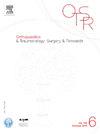Anterior cruciate ligament reconstruction using hamstring graft: Functional and laximetric results of a pedicled semi tendinosus technique compared to a pedicled semi tendinosus technique combined with anterolateral ligament reconstruction
IF 2.2
3区 医学
Q2 ORTHOPEDICS
引用次数: 0
Abstract
Introduction
The anterolateral ligament plays a key role in knee biomechanics. Its reconstruction, combined with anterior cruciate ligament (ACL) reconstruction, is not systematic but offers numerous advantages (reduced iterative ACL graft rupture rates, internal rotation control, and protection following internal meniscus repair) without increasing the risk of perioperative morbidity.
Hypothesis
ACL reconstruction using a semitendinosus graft combined with anterolateral ligament reconstruction using a gracilis graft (Group 2: ST + ALL) provides better functional and laxity outcomes on Dyneelax® Genourob than isolated ACL reconstruction using a semitendinosus graft does (Group 1: ST).
Methods
This was a retrospective, single-center study of 91 patients. Pre- and postoperative functional scores (KOOS 12, Lysholm scale score, ACL-RSI score, and Tegner scale score) were collected, along with automated laxity measurements (Genourob® Dyneelax) at the last follow-up. The minimum follow-up period was 18 months, with patients reviewed between 18 and 24 months.
Results
Clinical functional outcomes and laxity measurements at the last follow-up were significantly better in Group 2 (ST + ALL). ACL-RSI, Tegner scale score and its difference in pre- and postoperative, KOOS 12 postoperative score improvement, Lysholm score and its postoperative score improvement showed significant results in favor of group 2. The automated Genourob® Dyneelax measurement of residual laxity during anterior translation of the operated knee was 0.677 mm (±1.59) for Group 2 and 1.44 mm (±2.13) for Group 1 (p = NS). The internal rotation measurements were −0.671 (±2.3) for Group 2 and 1.64 (±2.98) for Group 1 (p < 0.001). The ligament reconstruction failure rate was 6.98% in Group and 18.75% in Group 1.
Conclusion
ACL reconstruction using a semitendinosus graft combined with anterolateral ligament reconstruction using a gracilis graft provides better functional and objective laxity results than isolated ACL reconstruction with a semitendinosus graft does.
Level of evidence
III; retrospective comparative study.
用腘绳肌腱移植重建前交叉韧带:带蒂半肌腱技术与带蒂半肌腱技术联合前外侧韧带重建的功能和松弛结果比较。
前外侧韧带在膝关节生物力学中起着关键作用。它的重建,结合前交叉韧带(ACL)重建,不是系统性的,但提供了许多优点(减少迭代ACL移植物破裂率,内部旋转控制,保护内部半月板修复),而不会增加围手术期发病率的风险。假设:使用半腱肌移植物联合股薄肌移植物重建前外侧韧带(组2:ST + ALL)在Dyneelax®Genourob上比使用半腱肌移植物重建单独的ACL(组1:ST)提供更好的功能和松弛效果。方法:对91例患者进行回顾性、单中心研究。收集术前和术后功能评分(oos 12、Lysholm量表评分、ACL-RSI评分和Tegner量表评分),并在最后一次随访时进行自动松弛测量(Genourob®Dyneelax)。最短随访期为18个月,患者随访期为18至24个月。结果:第2组(ST + ALL)最后一次随访时的临床功能结局和松弛测量明显更好。ACL-RSI、Tegner量表评分及其术前、术后差异、kos12术后评分改善、Lysholm评分及其术后评分改善均以2组显著。Genourob®Dyneelax自动测量术中膝关节前平移残余松弛度,2组为0.677 mm(±1.59),1组为1.44 mm(±2.13)(p = NS)。第2组的内旋测量值为-0.671(±2.3),第1组为1.64(±2.98)(p)。结论:半腱肌移植联合股薄肌前外侧韧带重建比半腱肌移植重建具有更好的功能和客观松弛效果。证据等级:III;回顾性比较研究。
本文章由计算机程序翻译,如有差异,请以英文原文为准。
求助全文
约1分钟内获得全文
求助全文
来源期刊
CiteScore
5.10
自引率
26.10%
发文量
329
审稿时长
12.5 weeks
期刊介绍:
Orthopaedics & Traumatology: Surgery & Research (OTSR) publishes original scientific work in English related to all domains of orthopaedics. Original articles, Reviews, Technical notes and Concise follow-up of a former OTSR study are published in English in electronic form only and indexed in the main international databases.

 求助内容:
求助内容: 应助结果提醒方式:
应助结果提醒方式:


